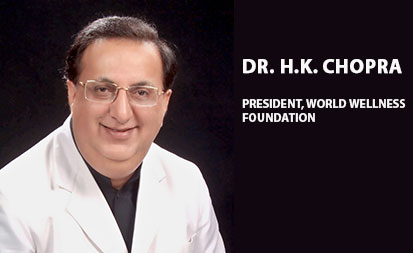Cholesterol Fitness: A Need of the Hour. (Be Cholesterol Fit & Get Rid off Heart Attack, Brain Attack and Leg Attack).
It is very important for all of us to understand about the beneficial and harmful effects of cholesterol. In fact, cholesterol is just one of the many substances created and used by our bodies to

It is very important for all of us to understand about the beneficial and harmful effects of cholesterol. In fact, cholesterol is just one of the many substances created and used by our bodies to keep ourselves healthy. Cholesterol promotes synthesis of cell membranes and is a very important component of many hormones in our body. It is also an important component of bile acids, which are required for digestion. Unfortunately, cholesterol does not get processed in a beneficial way every time. In other words, elevated levels of bad cholesterol is a major risk factor for the rising epidemic of heart attack, brain attack, leg attack and metabolic syndrome in our country. It is therefore necessary for all of us to understand how to control our cholesterol and reduce the risk for
Heart Attack and Brain Attack etc.
Q.1 What is Cholesterol and Metabolic Syndrome (Obesity Syndrome)?
Ans Cholesterol is a waxy, soft, fat-like substance found in all body cells and it does not dissolve in blood plasma. Most of the cholesterol found in the body is produced in the liver. 20-30% comes from the food we eat, which is necessary for the body, but having too much of it in your body can cause problems. Cholesterol is essential for life, cell membranes, growth hormones and sex hormones. However, high levels of bad cholesterol such as total cholesterol (CH), triglycerides (TG) and low density lipoproteins (LDL) may lead to premature hardening of the arteries in the heart, brain, peripheral arteries, aorta, kidney arteries, mesenteric arteries, carotid arteries or arteries in the eyes, etc. Narrowing of the arteries reduces the blood supply to the tissues, thereby reducing oxygen and causing tissue damage. High levels of bad cholesterol and low levels of good cholesterol (HDL – High Density Lipoproteins) may be responsible for premature heart attack, brain attack or leg attack in the younger population, especially those who are obese, smokers and diabetics and suffering from metabolic syndrome.
Metabolic syndrome (Obesity) is a cluster of potbelly (>90 cm in men and >80 cm in women), hypertension, high TG (>150 mg%), low HDL (<40 in men and <50 in women) and high fasting blood sugar (>110 mg%). I firmly believe that metabolic syndrome is an occult terrorist in South-East Asia, which sows the seed of premature heart attacks and brain attacks in our country. Metabolic syndrome prevalence, as documented in different parts of the world in community-based data, varies from 40-60%. In our own study (MMMSS 2007) published in Indian Heart Journal, we have shown that there is a rising trend of metabolic syndrome in in-hospital population, the overall prevalence is 65%. It is more in women, upto 70% and is 60% in men. It is highly prevalent in the age group of 40-50, because of faulty lifestyle including lack of exercise, eating the wrong food rich in cholesterol, at a wrong time, in the wrong place, in the wrong manner, in the wrong environment and because of negative stress such as negative competition, feelings of hatred, vengeance, vindictiveness, cynicism, hostility, excessive smoking and consumption of excessive alcohol, consuming less fruits, vegetables and nuts etc. I firmly believe that “most of us are walking emotional time-bombs of metabolic syndrome with seeds of premature CVD (Cardiovascular Disease) including heart attack, brain attack and leg attack in us. The time to combat is now by lifestyle optimization and timely, effective medicalisation”.
Q.2 What are the sources of cholesterol?
Ans Cholesterol is derived from two sources: it is manufactured in our body mostly in the liver and is found in foods from animal sources such as meat, egg yolk and milk products. Triglycerides (TG) are derived only from diet sources. Cholesterol derived from dietary sources is called as exogenous and the one synthesized in the liver is called as endogenous cholesterol. Please remember, any food from plant sources does not contain cholesterol.
Q.3 What are the types of cholesterol?
Ans Cholesterol can be classified as Bad Cholesterol and Good Cholesterol. The bad cholesterols are total cholesterol (CH), triglycerides (TG), low density lipoproteins (LDL) and very low density lipoproteins (VLDL). Good cholesterols are high density lipoproteins (HDL), which can be HDL-1, 2 & 3. The Bad Cholesterol increases the risk of heart attack, brain attack (paralysis) and leg attack (peripheral vascular disease). Oxidised high LDL cholesterol in excess forms plaque in the arteries and increases the risk of atherosclerosis (hardening of the arteries). Lp(a) cholesterol is a genetic variation of LDL (Bad Cholesterol). A high level of Lp(a) is a significant risk factor for the premature development of fatty deposits in the arteries. On the other hand, Good Cholesterol (HDL) is protective to the heart and brain and removes excess of cholesterol from the plaque and slows their growth, sometimes even decreasing its size. It lowers the risk of heart attack and brain attack.
Q.4 What is the relationship of cholesterol and your arteries?
Ans Cholesterol and other fats can build up in the walls of your blood vessels (arteries), feeding the heart and the brain. This condition is called as atherosclerosis, which is a type of arteriosclerosis. The name comes from the Greek words athero (meaning gruel or paste) and sclerosis (meaning hardness). It is the term for the process of fatty substances, cholesterol, cellular waste products, calcium and fibrin (a clotting material in the blood) building up in the inner lining of the artery. The buildup that results is called plaque. These plaques may be vulnerable or non-vulnerable. Vulnerable plaques may rupture, as they have thin fibrous cap, with high lipid core, and it promotes clot formation. This in turn narrows the arteries and diminishes blood supply to the heart, thereby causing heart attack, reducing blood supply to the brain, causing brain attack (paralysis), reducing blood supply to the lower limbs, causing leg attack. Cholesterol and other fats are transported in the blood to and from the cells by special carriers called lipoproteins. There are several kinds of lipoproteins. We are most concerned with two of them, i.e., Low Density Lipoproteins (LDL) and High Density Lipoproteins (HDL), both of which are carriers for cholesterol.
Q.5 What are the normal and risk levels of cholesterol?
Ans Normal range of blood cholesterol is 150-250 mg/dl. Ideally, the recommended levels of blood cholesterol in an adult should be <150 mg/dl. The cholesterol levels <200 mg/dl are desirable, 200-239 mg/dl are borderline-high risk, and >240 mg/dl are very high risk levels. The LDL cholesterol levels range from 70-150 mg/dl. Ideally, the recommended levels of LDL in adults should be <70 mg/dl. The LDL levels of <100 mg/dl are considered as optimal, 100-129 mg/dl are near optimal, 130-159 mg/dl are borderline high risk, 160-189 mg/dl are high risk and >190 mg/dl are very high risk. The triglyceride levels normal level is <150mg/dl, 150-199 mg/dl is borderline high risk, 200-499 mg/dl is high risk, and >500 mg/dl is very high risk. The recommended level of VLDL in adults should be 24-45 mg/dl. Higher levels of HDL cholesterol are better. The normal HDL cholesterol levels should be >40 mg/dl in males and >50 mg/dl in females. Lower levels of HDL (<40 mg/dl for men and <50 mg/dl for women) puts you at higher risk for heart attack and brain attack. The cholesterol/HDL ratio should be <4 and LDL/HDL ratio should be <3. Similarly, cholesterol/HDL ratio of >4, LDL/HDL ratio of >3 and LDL levels of >150 mg/dl have higher risk for brain attack and heart attack.
Q.6 Is cholesterol harmful or beneficial?
Ans Cholesterol is very important for life. It promotes synthesis of cell membranes, growth hormones, sex hormones and various other hormones. It is also necessary for synthesis of bile salts. However, in certain situations in which cholesterol levels are higher than normal, it may get deposited in the arteries, supplying blood to the heart muscle, causing angina of effort, followed by angina at rest or heart attack (complete blockage of the artery supplying blood to the heart. Similarly, it may diminish blood supply to the brain, causing TIA (Transient Ischemic Attack) or Brain Attack (Paralysis).
Q.7 How is high triglyceride level harmful to the body?
Ans The source of triglycerides is diet. If high, it may be an independent risk factor for heart attack and brain attack. Individuals with high levels of triglycerides of >200 mg/dl are two times more vulnerable to suffer from atherosclerosis than those with lower levels. The main strategy to reduce triglyceride levels is by optimising the lifestyle by eating low fat, low sugar and low cholesterol diet, regular exercise, reduce alcohol consumption, sometimes drugs may be required to reduce the triglyceride levels with the help of the treating physician.
Q.8 What are the facts about fats?
Ans Saturated fats are solid at room temperature. They are found in fats of animal origin such as beef, butter and cream. Coconut oil, though of plant origin, is solid at room temperature and has high saturated fat content. Increase in consumption of saturated fat increases cholesterol levels. On the contrary, unsaturated fats are liquid at room temperature. The sources of polyunsaturated fats are plants such as sunflower, corn and soyabean. Consumption of polyunsaturated fat oils lowers the blood cholesterol levels. Monounsaturated fats are in olive, peanut and avocado oils, which also lower cholesterol levels.
Q.9 What is the relationship between cholesterol and alcohol?
Ans Drinking too much alcohol can raise the blood pressure, cause heart failure and lead to brain attack and heart attack. It can contribute to high triglycerides, high blood pressure and irregular heart beats and may also contribute to obesity. Alcohol excess increases tendencies for metabolic syndrome, suicides and accidents. Alcohol consumption of 1-1.5 ounces per day may increase the levels of HDL. However, there are many other methods to increase the levels of HDL. The dangers of alcohol outweigh its benefits. It is, therefore, not recommended that non-drinkers should start using alcohol or that drinkers increase the amount they drink.
Q.10 What is the relationship between smoking and cholesterol?
Ans Smoking or tobacco consumption in any form lowers the level of HDL. The HDL level decline is greater in women smokers, as compared to men.
Q.11 What is the relationship between stress and cholesterol?
Ans Stress is a well-known killer. A number of studies have shown that cholesterol levels are high during different types of stresses such as facing an interview, before examinations, during training, loss of jobs, during surgery, difficult labour and many other stressful situations.
Q.12 What is the relationship between age and cholesterol?
Ans Advanced age is usually associated with high levels of bad cholesterol\
Q. 13 What is the relationship between cholesterol and Vascular age ?
Ans. Higher is the level of bad cholesterol and lower is the level of the good cholesterol higher is the vascular age.
Q.14 What is the relationship between sex of an individual and cholesterol?
Ans It has been shown that before menopause, women tend to have less incidence of heart attacks than men. This is because women have high levels of HDL and low ratio of Cholesterol/HDL.
Q.15 What is the relationship between coffee and cholesterol?
Ans It has been shown in various research studies that excess of coffee consumption (>4 cups per day) is associated with lower levels of HDL and higher levels of triglycerides and cholesterol. Excessive coffee drinking is seen in stressful individuals.
Q.16 What are the precautions one should undertake before undergoing cholesterol profile test?
Ans It is important that one should be fasting, at least for 12 hours, before undergoing blood test for lipids. One can take only water. Triglyceride levels may be elevated if one does not fast. It has been shown that cholesterol values may be high if high intake of saturated fats or cholesterol-laden food or excess of alcohol is consumed 24 to 48 hours prior to the test.
Q. 17 What is the recommendation of protocol for lipid profile check after the age of 30?
Ans. Lipid Profile should be checked on yearly basis after 30 and every six months after the age of 55. It can be individualized on doctor advised and patients comorbidities.
Q.18 Is there is a relationship between Lipid Profile and CT Angio Calcium Scoring ?
Ans. It has great clinical correlation.
Q.19 What is the role of diet in reducing cholesterol?
Ans Change in diet is the first step to control high blood cholesterol. The recommendations are to reduce the fat intake, so that less than 10% of total calories come from saturated fat and not more than 10% from polyunsaturated fats. Eat more of vegetables, fruits and nuts. One can have fish or chicken, but no red meat. One should avoid yolk of an egg. However, one can have egg white. One should avoid junk food, overfried food such as puri, halwa, paratha, samosa, pakora, cutlets, butter naan, fried potato chips, etc.
Q.20 What are the benefits of exercise and its influence on cholesterol ?
Ans Regular heart-friendly exercises such as walking, wogging, jogging, swimming, dancing, cycling and treadmill are excellent for a healthy heart and reduces the level of bad cholesterol and increases the level of good cholesterol. 30 minutes of exercise daily is a must.
In general, reducing the total levels of cholesterol by 1% will reduce the risk of heart attack by 2%. For example, lowering blood cholesterol from 250 to 200 mg/dl reduces the risk of heart attack by 40%.
Q.21 What should be the type of lifestyle optimization to have healthy heart, healthy brain and cholesterol-fitness in everyone?
Ans
• Exercise regularly, 30 minutes every day.
• Do not smoke or chew tobacco.
• Do not eat junk food/ fried food.
• Eat more of fruits, vegetables, salads, sprouts.
• Take nuts including American Pistachio, California Walnut.
• Take US Cranberry juice on daily basis.
• Do not consume excess of alcohol.
• Learn to cope with stress by practicing all eight limbs of yoga and meditation on a regular basis.
• Maintain your abdominal girth at <90 cm in men and <80 cm in women. No Potbelly.
• Eat the right food at the right time, in the right place, in the right dose, in the right environment.
• Have an annual health check-up after the age of 30.
• Have a perfect daily routine and work plan
• Please take statins as advised by your doctor.
I firmly believe that optimization of lifestyle in a disciplined manner, right from the childhood, including regular exercise, abstinence from smoking/excessive alcohol, junk and fast food, coping with negative stress by practice of yoga and meditation, will enhance cholesterol fitness with healthy heart and healthy brain and help us in curbing the rising menace of Brain Attack, Heart Attack and Leg Attack. Timely effective medicalization with statins is panacea.






